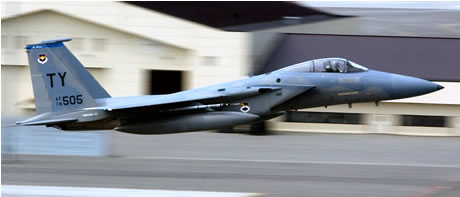An F-15D fighter jet crashed Friday (February 1, 2008) while on a training mission over Hawaii. While on a training mission over the Pacific ocean, the pilot could not control the plane and started to lose altitude and, managed to eject safely before the aircraft hit the sea. Brig. Gen. Peter Pawling, Hawaii Air National Guard’s 154th Wing commander said the cause does not appear to be related to structural problems that grounded the Air Force’s entire fleet of F-15s in November as Friday’s crash was ‘in one piece’. But Pawling said it’s too early to link the plane’s age to the crash, pending the ongoing investigation. Hawaii’s F-15s are about 30 years old and were acquired in 1987.
Air Combat Command officials cleared a portion of the F-15 Eagle A through D model aircraft Jan. 9 for flying status and recommended a limited return to flight for Air Force units worldwide following engineering risk assessments and data received from multiple fleet-wide inspections. However, almost 200 aircraft are still grounded, some may never fly again.
The return to fly order and recommendation applies only to those F-15 aircraft, about 60 percent of the total Air Force F-15 A through D fleet, that have cleared all inspections and have met longeron manufacturing specifications. The order and recommendation follows more than two months of stand-down actions after an Air National Guard F-15C aircraft experienced catastrophic structural failure and broke apart in flight during a basic fighter maneuver training sortie in Missouri Nov. 2, 2007. (see video animation)
Technical study of the F-15’s recovered wreckage determined that the component in question did not meet the manufacturer’s structural specifications and had developed cracks that caused it to fail, according to the report. According to the investigation’s findings, the upper right longeron – one of four metal beams that help hold the cockpit to the main fuselage – was found to have manufacturing defects, said Col. William Wignall, the head of the accident investigation. The one longeron, already not up to design specifications, cracked apart under the stress of a 7G turn, the colonel said. This led to the other longerons failing as well, which then caused the cockpit to separate from the rest of the fuselage. The pilot was able to eject, but suffered a broken arm when the canopy snapped off.
The long-term future of the F-15 is in question
Much of the U.S. Air Force’s 665 F-15s had been grounded since the incident. 441 F-15s in the Air Force inventory are model A through D. During the fleet’s grounding, every F-15 base conducted a series of detailed inspections. After the preliminary examination, 224 F-15E aircraft were returned to service as they were not affected by this specific problem. As of Jan. 9, the Air Force approved 260 of these aircraft (60 percent) to return to service with no flight restrictions. The remaining 182 of the aircraft, manufactured between 1978 and 1984 are remained out of service pending additional tests. Inspections determined that these aircraft have at least one longeron that does not meet blueprint specifications. Deviations in these longerons will be analyzed at the Warner-Robins Air Logistics Center. The analysis is expected to take approximately four weeks to complete. Once the analysis is complete, Air Combat Command will be able to better determine which aircraft will need further inspection, or repair, before returning them to flight.
Sofar nine of the inspected F-15s have been found to have longeron-fatigue cracks and have been grounded. The Air Force is scheduled to retire some of these aircraft this year as it may be cost-prohibitive to repair them. “We’re going over each and every aircraft to make a determination,” Gen. John D.W. Corley, the commander of Air Combat Command said. “We will take some F-15s out of the inventory. It just doesn’t make sense to spend the time and money if it won’t be worth it for some aircraft.”
The difficulty is that issues have been found with F-15s built between 1978 and 1985, across A through D models at several bases, so no one source of the problem can be isolated,. “This isn’t just about one pilot in one aircraft with one bad part,” General Corley said. “I have a fleet that is 100 percent fatigued, and 40 percent of that has bad parts.”
The Air Force first began flying the F-15 eagle in 1972. The Eagles are currently being replaced by the fifth generation F-22 Raptor, currently in production with active squadrons at Langley Air Force Base, Va., and Elmendorf AFB, Alaska. As F-15s operations were brought to ‘stand down’, F-22 Raptor, F-16 Fighting Falcon and F-15E Strike Eagle pilots have picked up the F-15s usual mission of patrolling and defending American airspace and interests. According to Gen. Corley, that has had a ripple effect among those pilots’ missions, General Corley said. “We don’t have a full and healthy fleet, so we’ve gotten behind on training missions, instructor certifications, classes and exercises,” he said. “And in the meantime, our pilots have to be ready to deploy.” Foreign air forces operating the F-15 Eagle followed the USAF and reduced operations of their Eagles to the minimum.
While the US Air Force may have other alternatives for air superiority fighters (such as the F-22 Raptor), the Japanese, Saudi and Israeli air forces face a major problem regarding their fleets of first line aircraft.
(Updated: January 11, 2008)

















